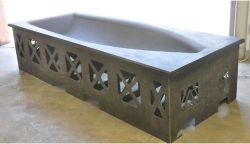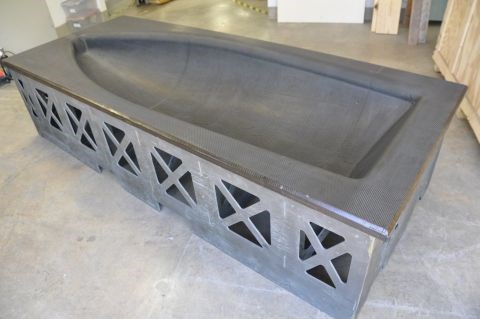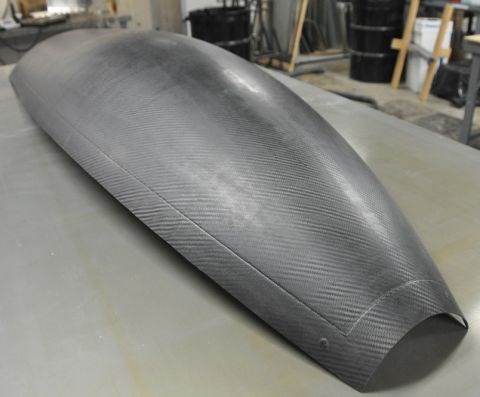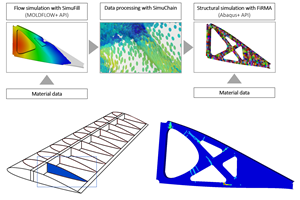Composite tooling without oven or autoclave
No Oven No Autoclave technology has been demonstrated in tooling for NASA, including multiple thermal cycles and use for curing epoxy infused out-of-autoclave parts.


1/10th scale petal (ogive and upper barrel) tool for NASA SLS payload fairing made using No Oven, No Autoclave (NONA) materials. SOURCE: NONA Composites.
Last year, I wrote a blog on the No-oven, No-autoclave (NONA) composites technology aimed at more cost-effective processing by eliminating the need for an oven or autoclave. Now I’m giving an update on where that technology stands with regard to composite tooling. A 177°C capable composite tool was fabricated for NASA and subsequently used to cure an infused epoxy part. This work was presented at CAMX 2014 and will be featured on the new NONA Composites web-site, slated to go live at the beginning of February.
NONA Composites (Dayton, OH, US) was spun off from Cornerstone Research Group (CRG, Dayton, OH) to commercialize two-part epoxy resin technology that enables room-temperature infused composites within hours using no additional heat source beyond the resin’s exotherm during cure. NASA is interested in this technology as one of a variety of materials and manufacturing methods for potential use in manufacturing large composite tools and structures for the Space Launch System (SLS) and other programs. NASA wants to take advantage of the weight and cost benefits of single-piece composite structures, but must remove the size restrictions and cost penalties of current processing to make these structures affordable.
Through Phase I and Phase II Small Business Innovative Research (SBIR) programs, Cornerstone Research Group and NONA Composites have been able to mature No Oven, No Autoclave composite processing to a Technology and Manufacturing Readiness Level (TRL/MRL) of 9. The latest demonstration reviewed at CAMX was a tool for fabricating a 1/10th scale petal (ogive and upper barrel) for a NASA SLS payload fairing. (Note: CW reported on a 1/6th scale tool made out of autoclave by Janicki in the Sep 2013 issue of HPC). The scaled fairing part made using NONA composites is approximately 192 cm long, 81 cm wide, and 41 cm high.
A master model for the tool was made by General Plastics (Tacoma, WA, US) using its FR-4718 high temperature polyurethane foam due to its low thermal conductivity and high temperature resistance. The machined foam was coated with Duratec vinyl ester primer and finished by hand. Airtech International (Huntington Beach, CA, US) Tooltec CS5 adhesive backed Teflon film was applied during the second tool facesheet fabrication described below.
The tool was built from the master model using NONA RT-177 two-part infusion resin. The resin was mixed by hand, degassed in a Laco Technologies (Salt Lake City, UT, US) degassing unit to an absolute pressure of 13.3 Pa (0.1 torr) over 10 minutes, and kept below 30 °C throughout the infusion. Simply stirring the resin maintains adequate temperature control for batches less than 1 kg. However, the larger batch size used for this tool fabrication required use of a static cold water bath and occasional stirring. Absolute pressure less than 133 Pa (1 torr) was maintained within the vacuum bag during infusion to increase fiber compaction and decrease laminate porosity.
Fabrics used for the tool included 2x2 twills made from 3k and 12k standard modulus carbon fiber. Two separate tooling facesheet trials were completed for development purposes. The first used a 28-ply, quasi-isotropic layup with the 3k 2x2 twill fabric and the second used fifteen 0° plies of the 12k 2x2 twill fabric. Flow media, resin feed tubing and valves, and vacuum bagging were all rated for 177 °C + because the NONA cure process generated heat during cure. Very low-cost bag-side insulation was used to maintain the heat of exotherm within the laminate during cure, which is critical to NONA processing.
The first tooling facesheet used 25 kg of resin and infused in 30 minutes while the second consumed 35 kg of resin and infused in 48 minutes. For both, the facesheet layups were debulked prior to infusion. Temperature in the NONA tool and master was logged with 32 thermocouples. For the second fabrication, the average temperature on the tool facesheet was 162.5 ±3.8°C. The first thermocouple peaked 165 minutes after the infusion, reaching 165 °C, and the last thermocouples on the part peaked 177 minutes after infusion, reaching 161 °C and 160 °C.
After reaching peak temperature, the system began to cool back down. Insulation was removed when the facesheet temps were between 40°C and 50 °C. A leak check to evaluate the vacuum integrity of the facesheet showed a rate of 0.46 torr/min over 24 minutes, measured with a digital vacuum gauge. This leak rate was determined more than sufficient for most prepreg and infusion applications.
Dimensional measurement of the second tool facesheet was performed using a ROMER Absolute Arm SI 3D laser scanner coordinate measurement system (Hexagon Metrology, North Kingstown, RI, US). Over 2.9 million points were collected. The assembled tool was heat-cycled with holds at 120°C and 177°C and allowed to cool down slowly to room temperature. CMM was performed again and the dimensions were shown to be very similar, ranging from -0.132 mm to 0.155 mm across the part area (average absolute deviation of 0.075 mm) , illustrating the thermal stability of the NONA resin and the resulting dimensional stability of the tool.
Infused carbon/epoxy part made using NONA Ogive tool for NASA.
SOURCE: NONA Composites.
This NONA tool was then used to fabricate a resin-infused composite fairing part. The tool was polished, sealed and coated with mold release. A 4-ply layup of 12K carbon 2x2 twill fabric was infused with Momentive Epon 862 epoxy resin using Epikure W curing agent. The part was cured during a 6.5 hr heating and cooling cycle, with a 1.5 hr hold at 177 °C. The cured part showed a smooth surface with little visible porosity and was sent to NASA Marshall Space Flight Center (Huntsville, AL, US), where multiple 177°C, 80 psi autoclave cure trials have been run without any issues.
“We’ve demonstrated that NONA can indeed be used to produce high-quality tooling without an autoclave or oven,” says NONA Composites president, Ben Dietsch. “Our goal now is to get NONA materials into more manufacturers so they can see the benefits of making tools with this technology.”
The company is also working to prove out machining parameters on large-scale NONA tools. CTO Michael Rauscher explains, “We’ve designed our materials so that you can get really good net-shaped tools without machining, even to tolerances of 0.127 mm. We believe if you can remove the machining step, it’s one less point for thermal degradation. However, there are manufacturers who do want to machine tools. Instead of developing a new NONA system, we are cycling current NONA tools that have been machined and showing the quality of part surface we can produce. We want the industry to see how well NONA compares to other tooling materials and that it is truly a robust tooling system.”
Dietsch adds, “We have a definite path for this technology. There continues to be a lot of interest and we’re talking to a lot of different primes. We’re also continuing our own capabilities to build increasingly larger tools.”
Related Content
Improving carbon fiber SMC simulation for aerospace parts
Simutence and Engenuity demonstrate a virtual process chain enabling evaluation of process-induced fiber orientations for improved structural simulation and failure load prediction of a composite wing rib.
Read MoreOptimized approach to predict delamination failure in CFRTP structures
ARRK Engineering and Mitsui Chemicals improved delamination prediction accuracy to help optimize absorbed energy/failure load for an overmolded TAFNEX CF/PP UD tape bumper beam.
Read MoreNine factors to consider when designing composites cure tooling
Gary Bond discusses the common pitfalls and compromises when designing good cure tooling and their holistic significance for a robust composite production process.
Read MoreCarbon fiber, bionic design achieve peak performance in race-ready production vehicle
Porsche worked with Action Composites to design and manufacture an innovative carbon fiber safety cage option to lightweight one of its series race vehicles, built in a one-shot compression molding process.
Read MoreRead Next
VIDEO: High-volume processing for fiberglass components
Cannon Ergos, a company specializing in high-ton presses and equipment for composites fabrication and plastics processing, displayed automotive and industrial components at CAMX 2024.
Read MoreAll-recycled, needle-punched nonwoven CFRP slashes carbon footprint of Formula 2 seat
Dallara and Tenowo collaborate to produce a race-ready Formula 2 seat using recycled carbon fiber, reducing CO2 emissions by 97.5% compared to virgin materials.
Read MorePlant tour: Daher Shap’in TechCenter and composites production plant, Saint-Aignan-de-Grandlieu, France
Co-located R&D and production advance OOA thermosets, thermoplastics, welding, recycling and digital technologies for faster processing and certification of lighter, more sustainable composites.
Read More























